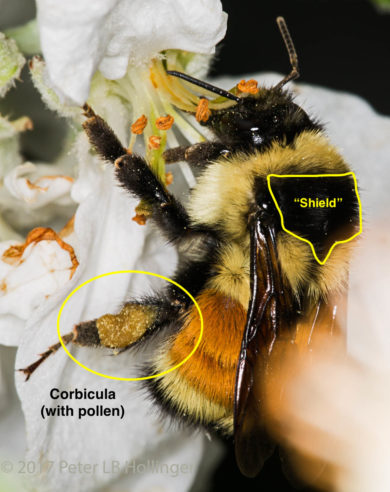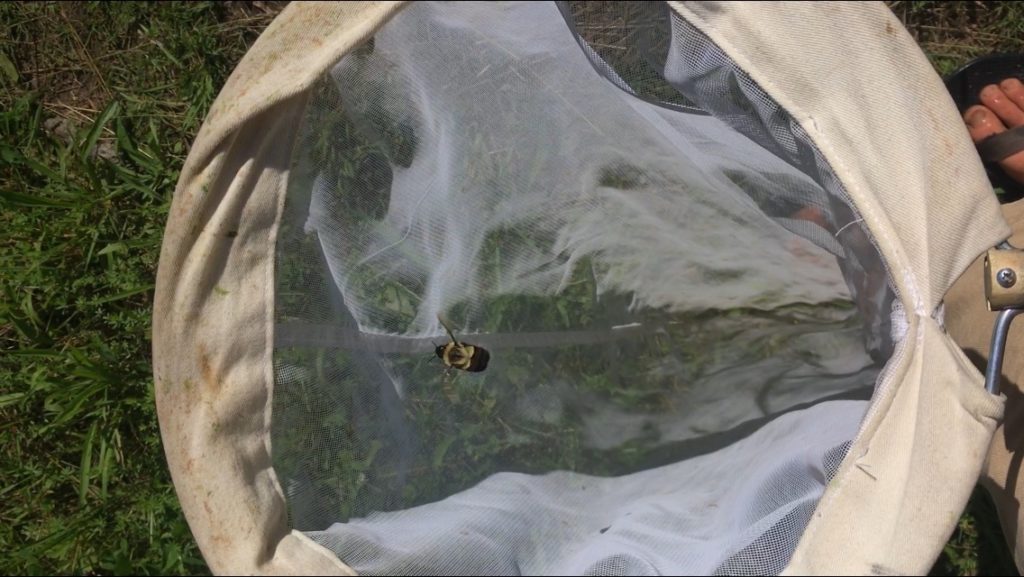This guide is meant to be a resource for anyone interested in identifying bumble bees in Vermont, and the surrounding states (all species currently found in the Northeast are included). With 17 species known from VT, and significant caste-level and individual variation, this genus can be daunting to ID, even in a limited geographic area. Not all individuals will be identifiable in the field, though with experience and good photos it is possible to rapidly ID many of the individuals likely to be encountered. This guide will be most valuable when used in conjunction with iNaturalist.org, as both a way to confirm IDs and contribute data. Written by Spencer Hardy with significant input from Leif Richardson.
What is a bumble bee?
Bumble bees are a genus (Bombus) in the order Hymenoptera. Unlike most of the native bee groups in the state, they are social insects with colonies and castes. Queens are the only castes to survive the winter. Having mated in the fall, they establish new colonies in the spring, then produce workers, and eventually males and new queens towards the end of the colony’s life. A small subset of species are parasitic, meaning their queens take over the colonies of other species, and as a result do not have a worker caste.
Queens and workers are both females and in the non-parasitic species have corbicula on their hind legs for collecting pollen. Males only exist for a short time at the end of the colony’s life cycle (July through October depending on the species). Males are generally hairier and lack the stinger, thus are safe to handle. With some trickier specimens, identifying the caste can be helpful for species ID. Sex can be added as an annotation on iNat, which can be used to sort images and mapped on the phenology graphs.
Other identification resources
- Discovery Life – Bumble Bee Key
- Bumble Bees of North America: An Identification Guide
- Bumble Bees of the Eastern United States (PDF)
- Minnesota Bumble bees: females and males.
- Species profiles from VCE’s Bumble Bee Atlas
Look-a-likes and mimics
Because bumble bees are a conspicuous part of many ecosystems and have a painful sting, they have inspired many different mimics. Some are quite convincing, even as species-specific mimics. A few are listed below, but there are insects in several orders that could easily be mistaken for a bumble bee. These are still valuable observations – please add your photo-observations of these, and all your biodiversity discoveries, to the Vermont Atlas of Life on iNaturalist.
- Anthophora bomboides (Bumble-bee-mimic Digger Bee)
- Laphria thoracica (Bee-mimic Robber Flies)
- Eristalis flavipes (Orange-legged Drone Fly)
Important Morphology
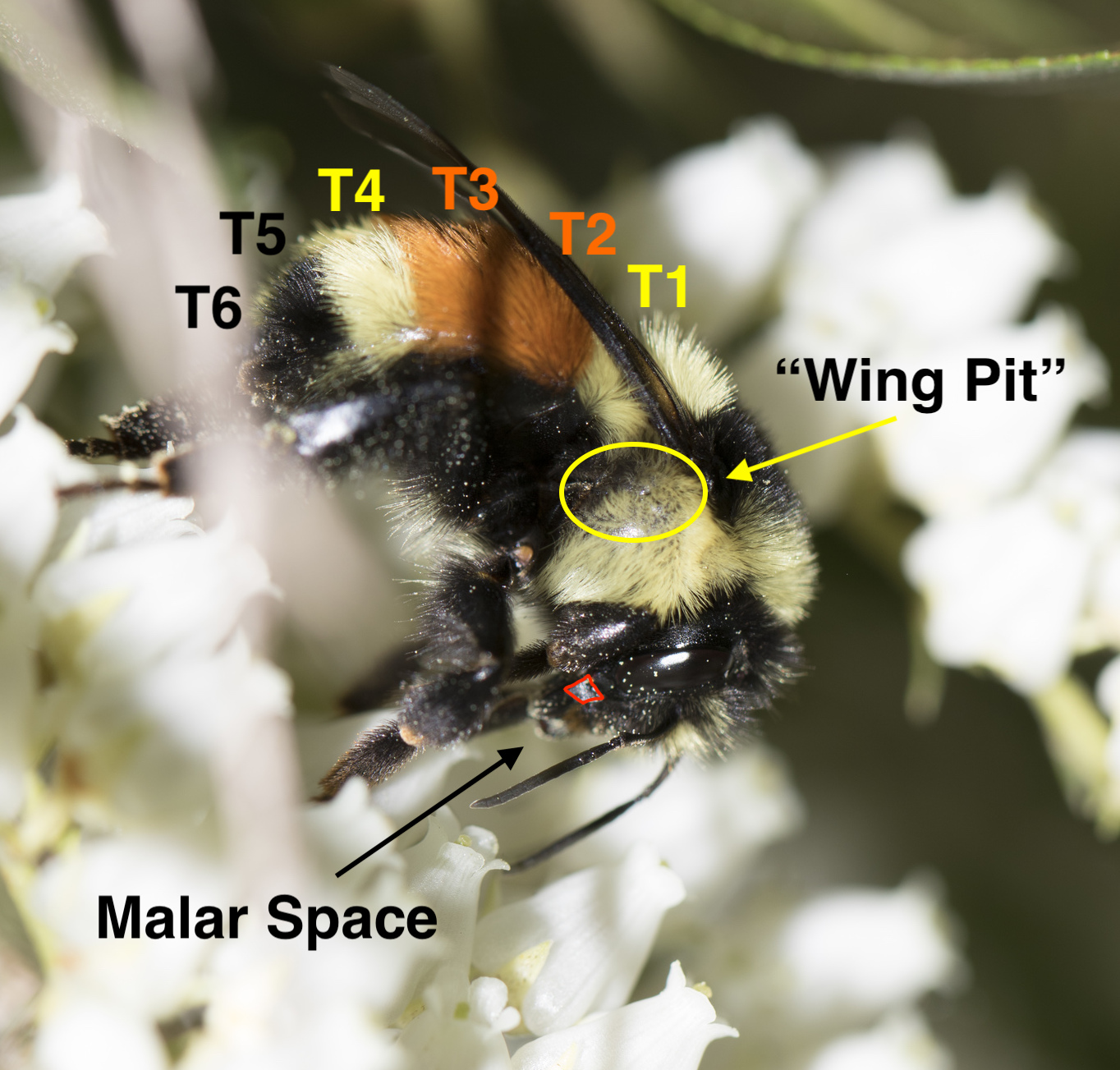
Photo © Kent McFarland
Terga
The abdomen of all bees is split into 6 (females) or 7 segments (males) called terga. T1 is the segment closest to the head. The actual distinctions between the segments can be hard to see, but hair color usually maps pretty closely, thus it is useful to refer to the color of each terga.
Wing Pit
Hairs on the side of the thorax behind where the wings attach. These haris are either predominantly yellow or predominantly black.

Variation in malar space ratios. Left to right: B. rufocinctus (~.5), B. ternarius (~1), B. fervidus (~2). All photos courtesy USGS Bee Inventory and Monitoring Lab.
Malar Space
The technical term for a bee’s cheek. Within Bombus the ratio of length to width varies considerably and is an important ID feature. The ratio is often expressed as W:L and varies from roughly 1:2 to 2:1.
Thorax
The thorax is the segment between the head and the abdomen. In most VT bumble bees, it is hard yellow with black hairs in the center. The black mark varies from practically non-existent to a large shield shape and is often useful for ID. Males generally have more yellow hairs and thus less distinctive black marks on the thorax.
Corbicula
Females of the non-parasitic species have modified structures on their hind legs for collecting pollen. The center of the hindleg is hairless and shiny and surrounded by longer hairs.
Photographing tips
Photographing bumble bees is the best way to get positive identifications (without collecting). Getting multiple photos from different angles is preferable, with the most important shot being from above, ideally with the wings spread, as the abdomen pattern is important for most species. Face and side shots are also helpful. Recording videos and later selecting the best frames is a great way to make sure you capture all the field marks. As with other wildlife, moving slowly and being patient make getting photographs much easier. It is often possible to approach within a few inches of a feeding bumble bees (especially workers and males).
Another great way to photograph bees (and other insects) by catching them with a net and putting them in a clear vial. Once restrained bumble bee bees can also be cooled down in a refrigerator or on ice, which will make them briefly sluggish and easier to observe.
For queens and distinctive species the fastest way to get identifiable images is using a net and the video function of a smartphone. Film the bees as they find their way out of the net and later select the frames (by taking a screenshot) that show the distinctive characteristics. An example photo using this technique is below (species ID in the photo links section).
Preferred flowers
All bumble bees are generalists so can be found on a wide range of flowers, especially considering that some species are active from April to October. However, some flowers are more attractive to certain bumble bee species and some sites there is significant flower segregation by species. Included in each species account is a partial list of the flowers that a given species seems to prefer. This can be helpful when targeting particular species but is far from definitive. Flower associations can (and should) be added to bee observations on iNaturalist.
Subgenera
Within Vermont, there are 5 subgenera within the genus Bombus. These groupings represent genetic similarities and can be helpful in narrowing down the options when identifying tricky individuals. Morphological features such as eye size and hair length are relatively well conserved within these groups. The Pyrobombus subgenus is far and away the most common in the state, and is a good basis to compare too. The malar space of Pyrobombus varies from roughly square (1:1 ratio) to slightly longer than wide (1:1.5 ratio). Other groups have more extreme rations (both smaller and larger). The subgenus Psithyrus includes all the parasitic species in the state and are distinctive in their lack of corbicula (they have no need to collect pollen).
Start here – Common species only
- Is there red on the abdomen?
Yes: B. ternarius or B. rufocinctus. See also B. impatiens, B. griseocollis.
No: 2
- Is the abdomen:
> 50% black: B. impatiens, B. bimaculatus, B. griseocollis
~ 50% black: B. vagans/B. sandersoni, B. perplexus, B. rufocinctus
< 50% black: B. fervidus, B. borealis, B. terricola, see also B. perplexus
Species with red or orange
Bombus (Pyrobombus) ternarius (Tricolored Bumble Bee)
Perhaps the most recognizable species in Vermont, widespread and common, though less so in the Champlain Valley. Often abundant late in the season on asteraceae (esp. goldenrods).
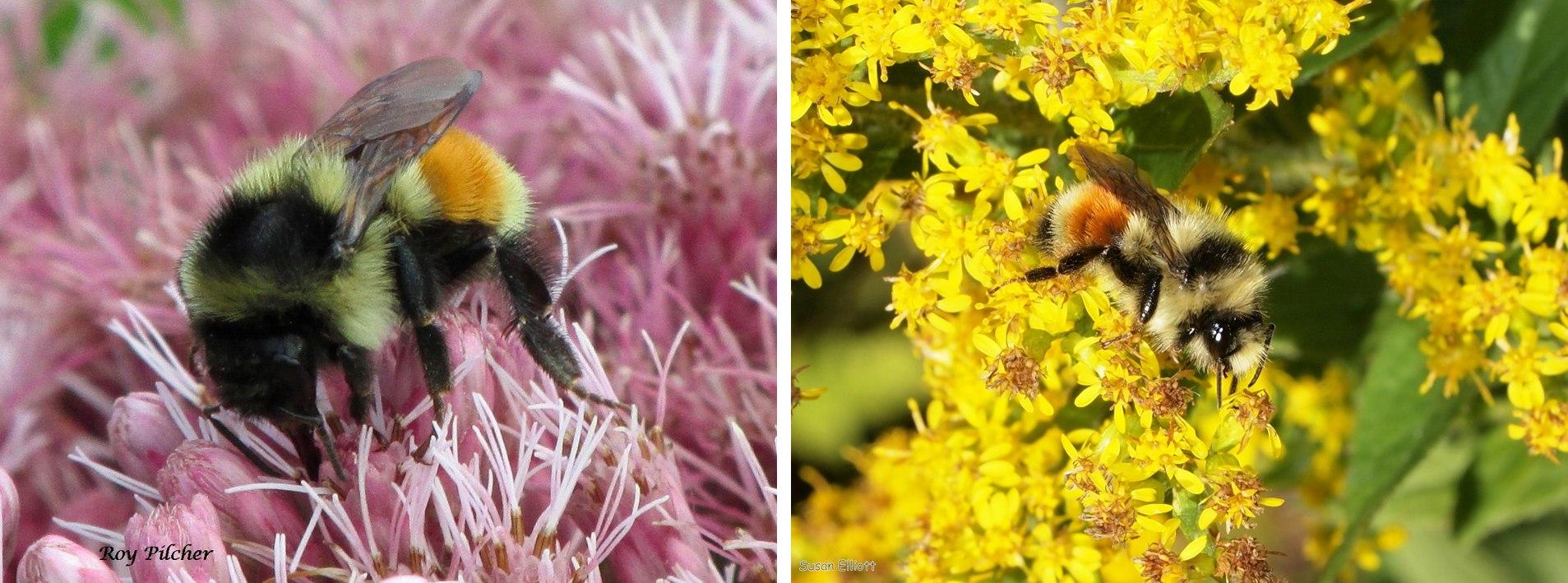
Left: Female © Roy Pilcher Right: Male © Susan Elliott
ID: The YRRYB pattern on the abdomen is distinctive, as is the black ‘shield’ like pattern on the thorax. Proportions, hair length, and male eye size similar to other pyrobomus. Males look like hairy, yellower workers.
Similar species:
B. rufocinctus: The only other species with significant red/orange, though rarely with yellow then black after the red. Never has the black shield on the thorax, males have much larger eyes.
B. borealis: Pale and/or faded female B. ternarius can look remarkably similar to B. borealis, though T1 and T4 are almost always a shade or two lighter than T2 and T3. B. borealis also lacks the distinctive black shield on the thorax.
Flight period: April – October (males rarely persist into early November).
Preferred flowers: goldenrods, joe-pye weed, dandelions, boneset, st. john’s wort, white clover, brambles
Bombus (Cullumanobombus) rufocinctus (Red-belted Bumble Bee)
Far and away the most variable Bombus in the northeast. It usually has at least a bit of red on the abdomen, though perhaps ~25% of individuals don’t. Generally a northern species, but in Vermont not commonly found outside the Champlain Valley, with a few records for Washington and Orleans County.
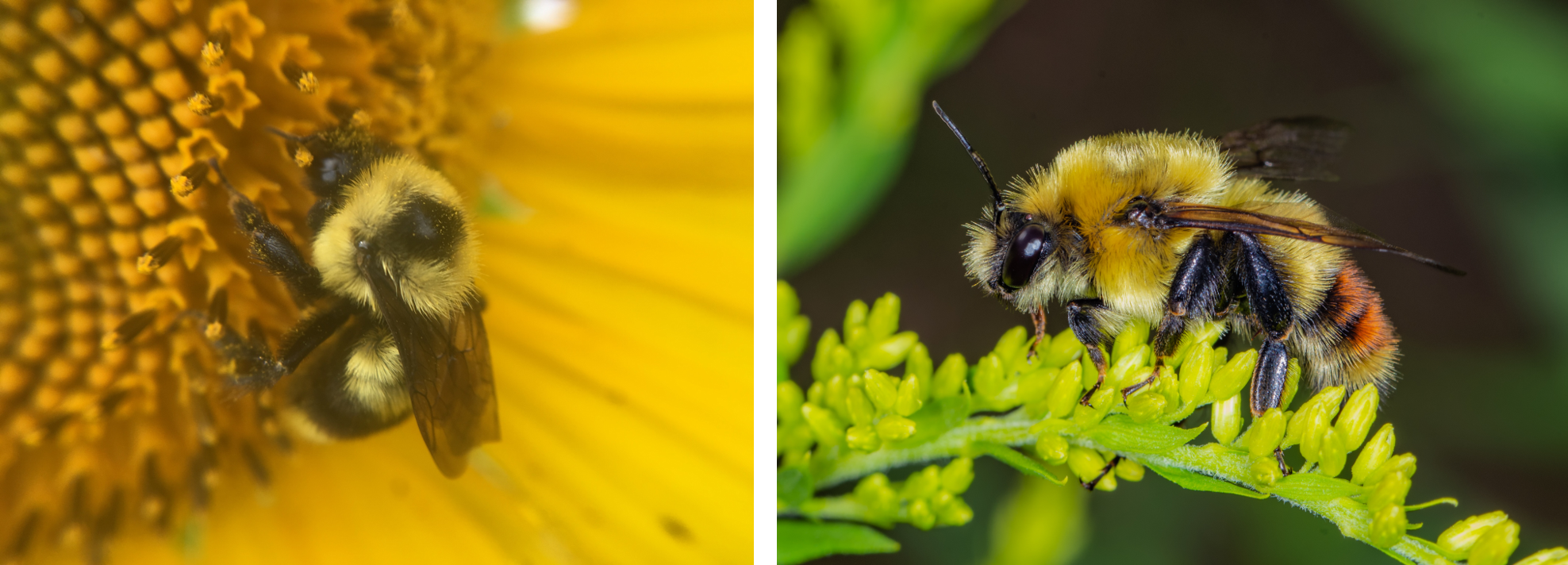
Left: Female © Spencer Hardy Right: Male © Bob Nobble
ID: Abdomen pattern variable, can be quite similar to B. ternarius, B. vagans/sandersoni, or the Psithyrus subgenus. Click here to explore some of the variation in this species. When present, the red hair is often brighter and/or more limited than B. ternarius. B. ternarius will never have red on T1. With B. rufocinctus, if there is red on T2 or T3, then T4 is almost never yellow. Many of the B. rufocinctus without red have yellow bands on T1 and T4, though occasional specimens only have yellow on T1 and T2 thus appear superficially similar to B. griseocollis or B. vagans. The black mark on the thorax is usually oval shaped unlike the round or shield shaped marks in other species. All females have relatively short hair and very short faces, which give them a cute, soft gestalt. Males have large eyes and often perch high on vegetation near flowers and aggressively pursue potential mates.
Similar species: Superficially similar to many other species, but with experience B. rufocinctus has a relatively distinctive ‘feel’.
Flight period: May – September. Peak abundance in July.
Preferred flowers: blueberry, clovers, goldenrod, thistles, other asteraceae
Species with limited yellow on abdomen
Bombus (Pyrobombus) impatiens (Common Eastern Bumble Bee)
By far the most commonly encountered bumble bee in Vermont – at some sites, can be incredibly dominant, especially late in the season. Appears more tolerant of development than most other species and is less common at heavily forest sites, though can show up anywhere, from the alpine zone of Mt. Mansfield to downtown Burlington.
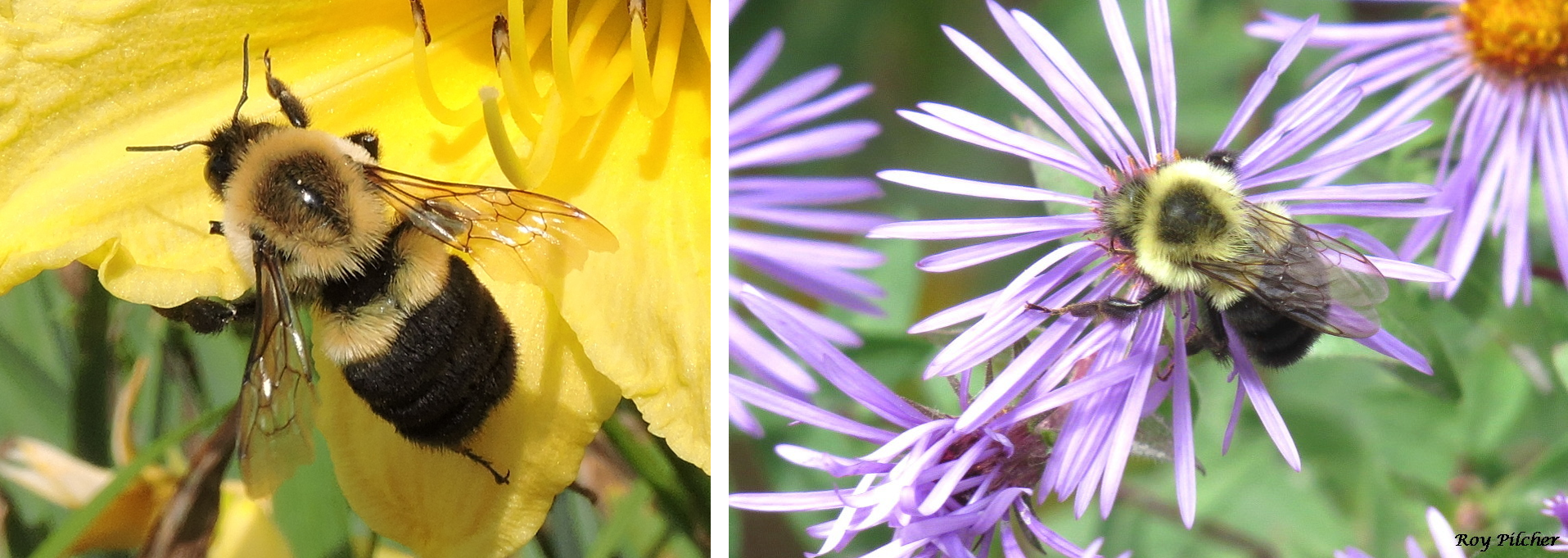
Left: Female © Judy Welna Right: Male © Roy Pilcher
ID: The only species without any yellow on T2, though there are occasionally a few yellow hairs at the top of T2 . Shorter haired than similar species, with a dusky smudge instead of a well defined dark spot on the abdomen. The yellow on T1 usually appears slightly concave in the middle. Occasional specimens (<1%) have a reddish tinge to the otherwise black hair on T2 – T4 (see example here). Males are similar to females, and rarely appear before late August.
Similar species:
B. bimaculatus: has a similar pattern on the abdomen, though brighter yellow with longer hair. Always at least a few yellow hairs in the middle of T2.
B. vagans/B. sandersoni: can be superficial similar, as T1 and T2 can be hard to distinguish when both are yellow.
Flight period: April – October. Peaks in September. Males can persist into November in warm years/areas.
Preferred flowers: Most any flower visited by other bumble bees.
Bombus (Pyrobombus) bimaculatus (Two-spotted Bumble Bee)
An early season, widespread species most similar to B. impatiens.
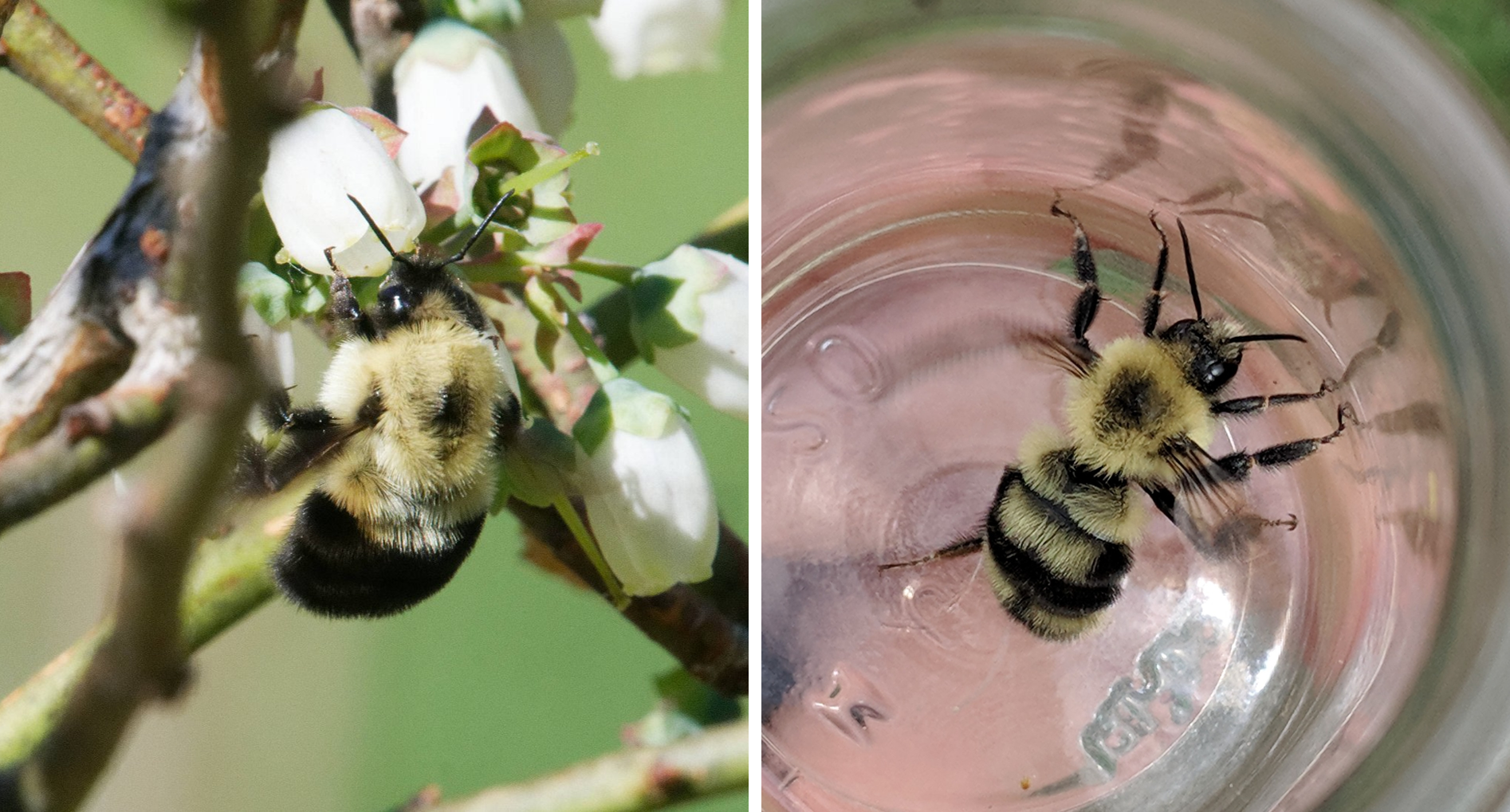
Left: Female © David Hoag Right: Male © Nathaniel Sharp
ID: Straightforward with a clear view of the upper thorax. T2 always with some yellow in the middle, which can range from a very distinct square to a few hairs along the edge closest to the head. The thorax has perhaps the most distinct black dot of any Vermont bumble bee. Males are quite variable, with some looking similar to females and others having expensive yellow on T3 – T5. Males appear as early as June and are gone by September.
Similar species:
B. impatiens: The thorax has shorter hair, with a grayish smudge in place of the distinct black dot on B. bimaculatus. B. impatiens rarely has any yellow on T2.
B. griseocollis: Also has a patch of yellow/brown in the middle of T2 and some workers can be pretty similar. In B. griseocollis the patch on T2 is often a dirty yellow, approaching brown and concave vs. the bright yellow square on B. bimaculatus. Additionally B. griseocollis has short, even hair appearing like a buzz cut with a very clean transition from yellow to black behind the head. B. bimaculatus usually has a small triangle of yellow hairs on the top of the head between the eyes.
B. rufocinctus: Can be similar to B. bimaculatus drones, though male B. rufocinctus have larger eyes.
Flight period: April – September. Peaks in July.
Preferred flowers: Rhododendron, dandelion, ground Ivy, st. john’s wort
Bombus (Separatobombus) griseocollis (Brown-belted Bumble bee)
The distribution of this species is quite patch across the state (and the country), though at some sites it can be quite abundant. Seems to have an affinity for gardens, farms, and other semi-developed areas, especially in the warmer parts of the state.
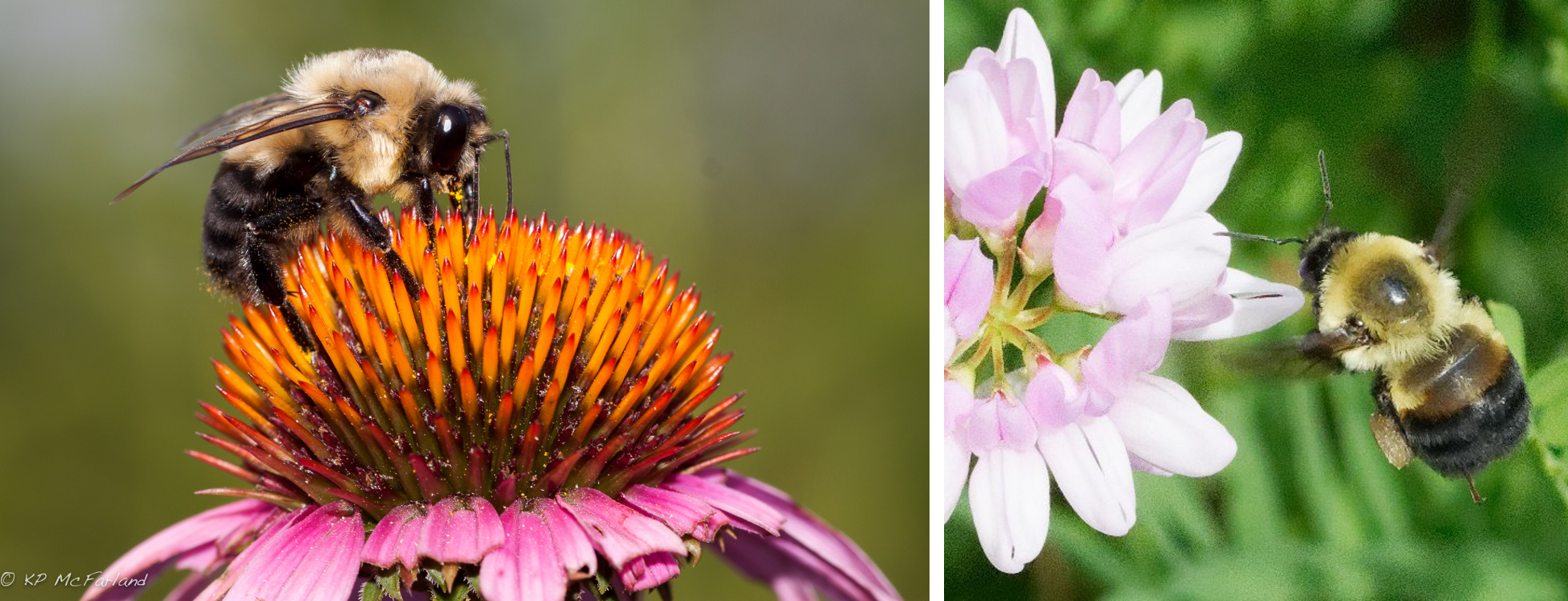
Left: Male © Kent McFarland Right: Female © David Hoag
ID: A short-haired species with a color pattern most similar to B. bimaculatus. T1 yellow, T2 with a central arc of yellowish brown (hence the common name). The brownish amber color of T2 is distinctive, and should not be confused with the rusty red of the formerly common B. affinis. Males have large eyes and extensive yellow hairs below.
Similar species:
B. bimaculatus: A longer haired, generally yellower bee. The yellow patch on T2 is squared-off vs. arched in B. griseocollis.
B. rufocinctus: A very small portion of B. rufocinctus don’t have red or yellow beyond T2 and can be similar to B. griseocollis, though the very short malar space (check) on B. rufocinctus is a give away.
Flight period: May – September. Peaks in July.
Preferred flowers: Milkweed, joe-pye-weed, pickerel weed, echinacea and other spinny things
Species with roughly half yellow, half black abdomens
Bombus (Pyrobombus) vagans (Half-black Bumble Bee)
One of the most abundant species in Vermont, especially in forested areas. Appears to be declining in some areas, especially in the western part of the state. Trends are complicated because this species is not reliably identifiable in most photos.
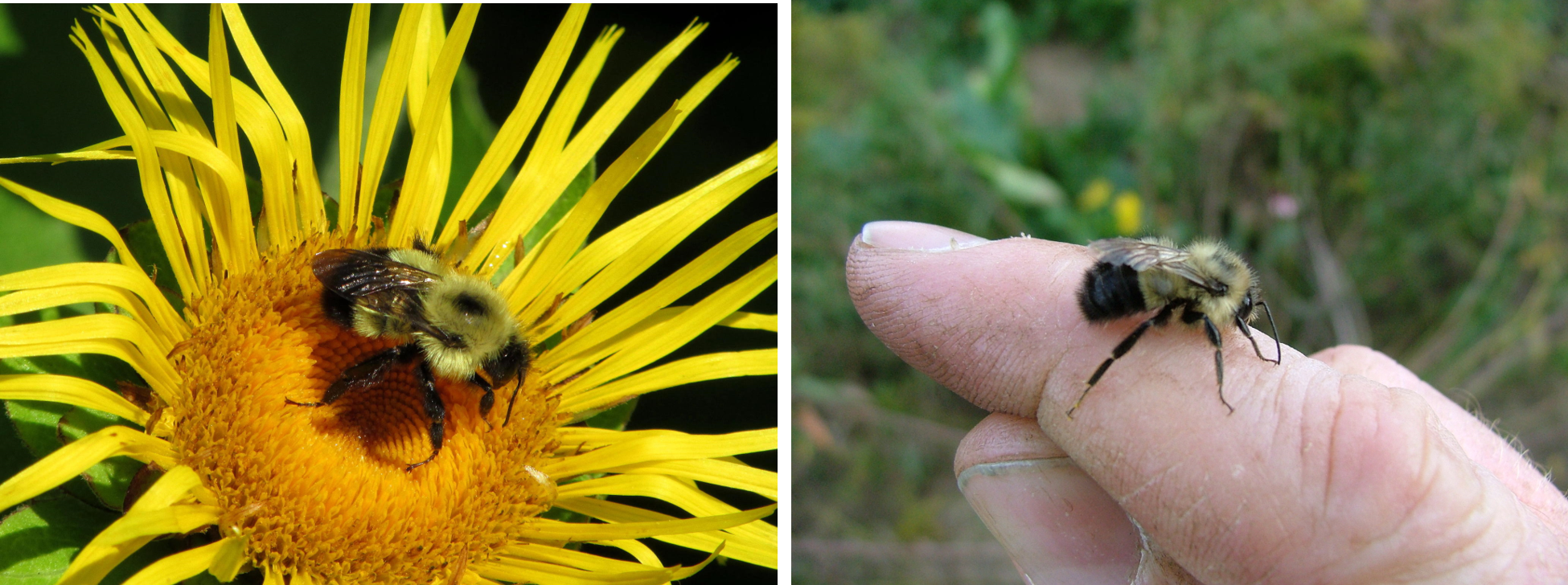
Left: Female © Roy Pilcher Right: Male © Kyle Jones
ID: This group of the subgenus Pyrobombus has T1 and T2 both completely yellow with the rest of the abdomen black. B. vagans is virtually indistinguishable from the much rarer B. sandersoni without a magnified view of the cheek.
Similar species:
B. sandersoni: Much rarer, but very similar. The best way to distinguish B. sandersoni and B. vagans is the shape of the malar space (cheek). In B. sandersoni, the width is roughly equal to the length, whereas in B. vagans, the length is slightly longer than the width. There is overlap, but B. sandersoni tends to have more black between the wings and queens often have white hairs on T5 and T6.
B. perplexus: Similar to B. vagans in that both species have yellow on T1 and T2. B. perplexus has a relatively distinctive hair color best described as egg yolk – darker and oranger than the pale yellow of most other bumble bees. B. perplexus lacks black between the wings but has noticeable black hairs below and behind the wings.
Flight period: May – October.
Preferred flowers: Jewelweed, thistle, meadowsweet
Bombus (Pyrobombus) sandersoni (Sanderson’s Bumble Bee)
A relatively rare and poorly known species, in part because of challenges with identification.
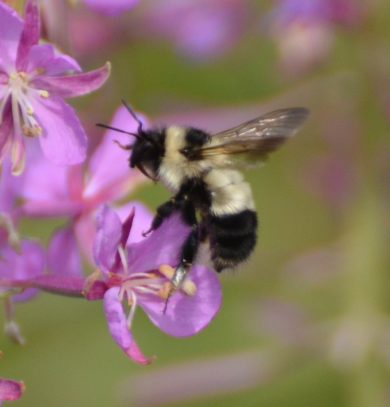
Female © Mark Olivier
ID: Very similar to B. vagans.
Similar species:
B. vagans: Nearly identical and much more common. The best way to distinguish B. sandersoni and B. vagans is the shape of the malar space (cheek). In B. sandersoni, the width is usually slightly less than length, whereas in B. vagans, the length is a tad longer than the width. B. sandersoni tends to have more black on between the wings and queens regularly have white hairs on T5 and T6 (though apparently other species can occasionally show this).
Flight period: May – August
Preferred flowers: Brambles, Apple
Bombus (Pyrobombus) perplexus (Perplexing Bumble Bee)
An early season bee that is rarely abundant, but widespread. Often one of the first to produce workers in late May/early June.
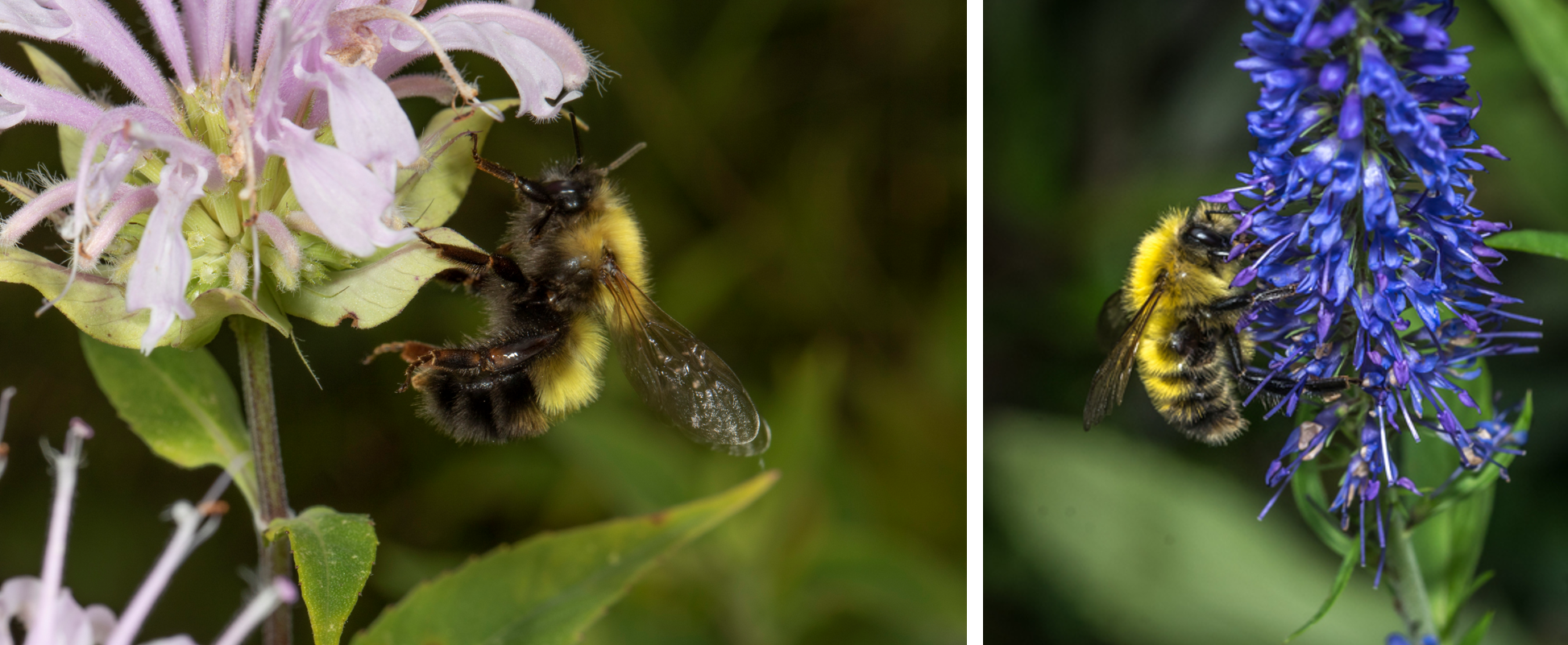
Left: Female © Kent McFarland Right: Male © Janet Nelson
ID: Despite the name, this species is usually relatively straight-forward to ID. The shade of yellow is best described as hard-boiled egg yolk and quite distinct from the pale yellow of other pyrobomus species. Queens and workers usually don’t have much, if any, black between the wings and have black ‘armpits’. Males are more variable and can be challenging.
Similar species:
B. vagans/B. sandersoni: These two species are nearly identical and similar to B. perplexus, however both have black between the wings, yellow ‘armpits’ and are a paler shade of yellow.
B. citrinus: Males can be similar to B. perplexus in that they both often have complete yellow on T1-T3. B. citrinus have predominantly black hair on the face, whereas B. perplexus are much yellower. Males of the two species are unlikely to overlap much, as B. citrinus males don’t often appear before the end of August.
Flight period: May – August (Peak in July)
Preferred flowers: Mints, thistles, milkweed, purple-flowering raspberry
Species with abdomens predominantly yellow
Bombus (Bombus) terricola (Yellow-banded Bumble Bee)
Imperiled globally (G2G4) and threatened in Vermont this has been one of the bumble bees species of greatest concern. Like other species in the subgenus Bombus, B. terricola showed drastic declines in the early 2000’s, but has rebounded nicely in most of Vermont (though not as much in other parts of its range). It can be found statewide, though it is more abundant in the cooler parts of the state.
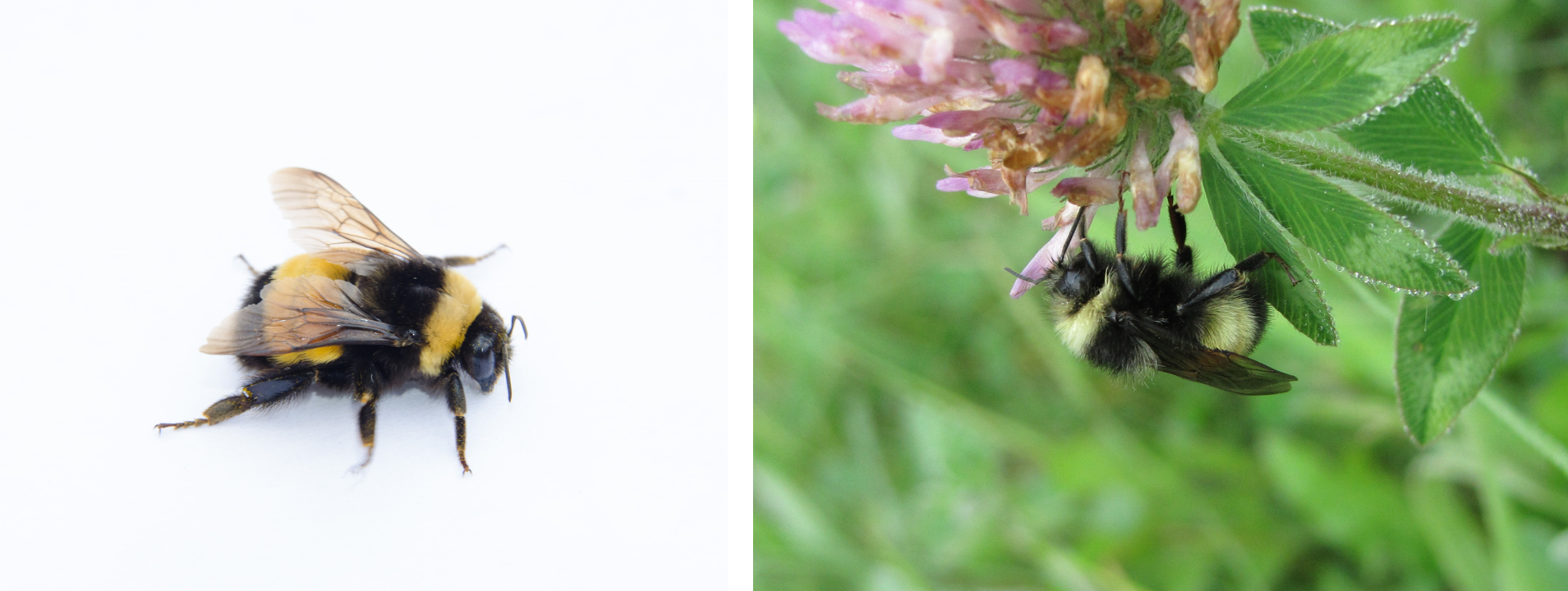
Left: Female © Spencer Hardy Right: Male © Sarah Carline
ID: Among common Vermont bees, this species is unique with a BYYBBB abdominal pattern and a thorax that is predominantly black on the rear 2/3rds. Two other species previously found in Vermont, B. pensylvanicus and B. auricomus have similar patterns and may one day re-appear in the Champlain Valley. Both are larger bees with a less fuzzy look and darker wings.
Similar species: No other common species in Vermont are similar.
Flight period: April – September (Peaks in July)
Preferred flowers: Willows, joe-pye-weed, goldenrods
Bombus (Subterraneobombus) borealis (Northern Amber Bumble Bee)
A large, amber colored bee that is hard to overlook if it is present. Historically more common in the northern parts of the state, it seems to be spreading south. Never abundant but not terribly uncommon.
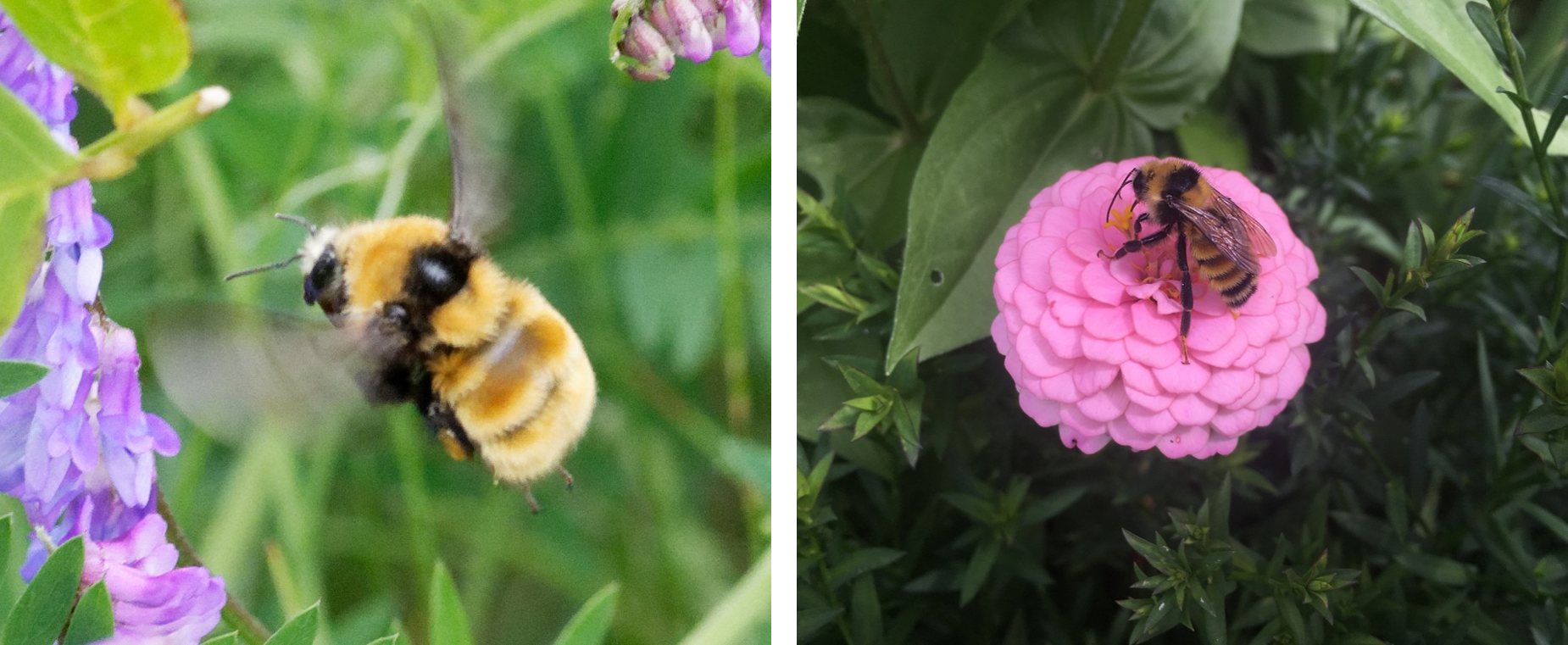
Left: Female © David Hoag Right: Male © Spencer Hardy
ID: One of two predominantly yellow species in the east. Usually significantly oranger than B. fervidus. Other distinguishing features are a wide, black bar between the wings, yellow hairs on the face, and dark armpits.
Similar species:
B. fervidus: A paler yellow than B. borealis, B. fervidus has yellow arm pits, a black face, and a thinner dark line between the wings.
B. ternarius: Faded females can be remarkably similar to B. borealis, at least in abdominal color. With B. ternarius there should still be some contrast between the red and yellow segments and the black shield between the wings may still be discernible.
Flight period: May – October (Peaks in July)
Preferred flowers: Red Clover, vetches
Bombus (Fervidobombus) fervidus (Golden Northern Bumble Bee)
Globally vulnerable and S1/S2 in Vermont, this species has perhaps the most specific habitat needs of any bombus currently found in VT. Formerly widely distributed in the state this species appears to need large, open fields and consequently is currently very rare outside of the Champlain Valley.

Left: Female © Kai Jenkins-Mui Right: Male © Ken Potter
ID: A large yellow species with a thin black line between the wings. Long black face with yellow wing pits.
Similar species:
B. borealis: With amber hair instead of yellow. B. borealis also has black armpits, yellow hair on the face, and a thicker line between the wings.
B. pensylvanicus: Females have black on T1, but males can be very similar to B. fervidus, though usually have at least a few orange/red hairs on T7. Last seen in VT in 2000, this species still persists to the south and west of Vermont.
Flight period: May – October (Peaks in September)
Preferred flowers: Red clover, vetch
Parasitic species (subgenus Psithyrus)
These species are social parasites of other bumble bees. Instead of a queen producing a bunch of workers to raise the next generation, species in this subgenus take over the nests of other bumble bees and force their works to raise new queens and drones of the parasitic species. Thus this group does not have worker castes and is generally much rarer than their hosts.
As a group, this subgenus is relatively distinctive, mostly as a result of their unique natural history. Females are generally less ‘hairy’ with shinier, curved abdomens and harder exoskeletons (protection from the stings of potential hosts, but also noticeable when pinning). The most distinctive fieldmark is the lack of corbicula, since they don’t need to collect pollen. Males also have a relatively unique feel, in part due to their short faces. Species level identification of this subgenus can get tricky and some males are best identified by microscopic differences in the genitalia. Luckily the two species likely to be encountered in VT are usually field identifiable.
Bombus (Psithyrus) citrinus (Lemon Cuckoo Bumble Bee)
Currently the most common Psithyrus species in the state, though far from common. Historically more widespread, though now most often found in the Champlain Valley, and only regular in a few areas.
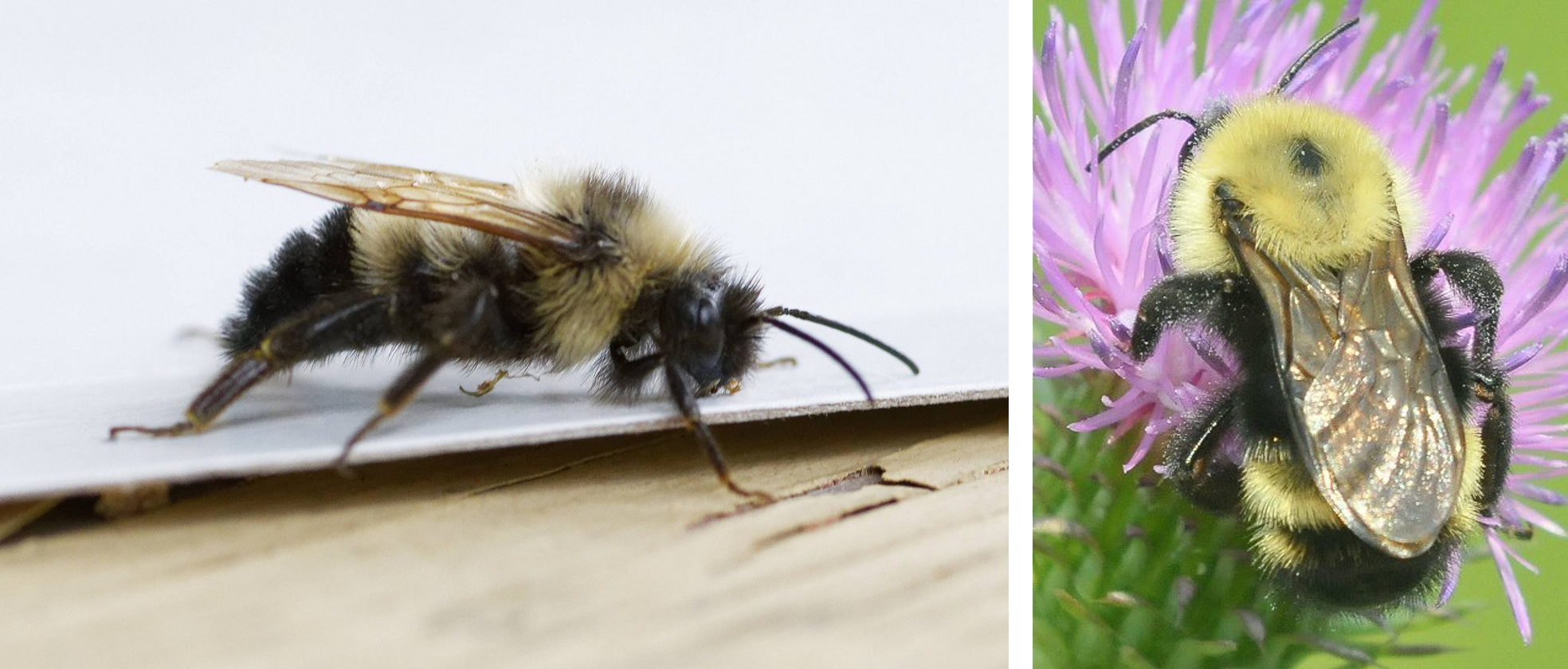
Left: Male © David Hoag Right: Female © David Hoag
ID: Queens are unique in the regional fauna, usually with a single yellow band on T3 and the rest of the abdomen black. Males usually have T1-T3 yellow which combined with the short, black face eliminate most other species.
Similar species:
B. fernaldae: Queens yellow on T1 in addition to the yellow band on T3. Males are quite variable, but usually have some orange/red hairs on T7.
B. perplexus: Males can be similar with extensive yellow on T1-T3, though in B. perplexus the yellow often extends further down the abdomen.
B. rufocinctus: Queens can occasionally be similar, and the short face of B. citrinus is reminiscent of B. rufocinctus. Female B. rufocinctus have corbicula, unlike Psithyrus sp.
Flight period: July – October (Peaks in September)
Bombus (Psithyrus) fernaldae (Fernald’s Cuckoo Bumble Bee)
Until recently a very rare species in the state, with two known records prior to 2018 (1936 and 1963). Found two places in Franklin County in 2018, and in 2019 found in Caledonia and Bennington Counties (thanks to iNat!). Other recent records from New England suggest it is expanding into the region.
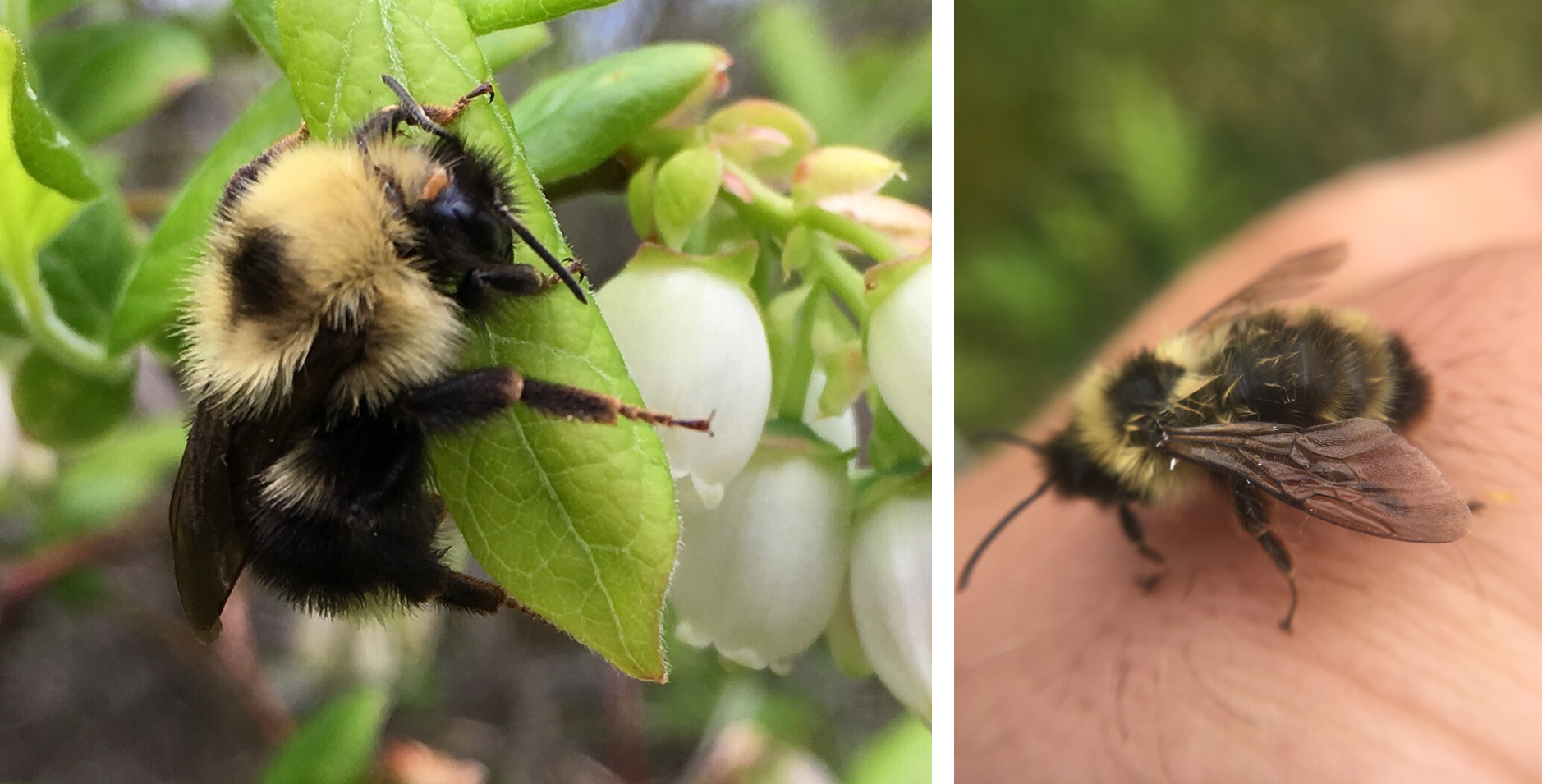
Left: Female © Leif Richardson Right: Male © Spencer Hardy
ID: Queens have yellow bands on T1 and T3, whereas males are quite variable. Most male B. fernaldae have some orange/red hairs on the tip of the abdomen (T7).
Similar species:
B. citrinus: Queens are similar, though usually don’t have yellow on T1 or as large of a black dot on the thorax.
Flight period: May – August (Peak in July)
Likely extirpated
Bombus (Fervidobombus) pensylvanicus (American Bumble Bee) – Historically abundant in at least Chittenden and Addison County, the last Vermont record was in 2000. Fond of large grasslands, and still present northeast of Lake Erie, this species may someday be re-found in VT.
Bombus (Bombus) affinis (Rusty Patched Bumble Bee) – This species was once one of the most abundant bumble bees in the state, but has not been found since 1999. It is now Critically Endangered Globally and only found in and around Wisconsin and Minnesota.
Bombus (Psithyrus) ashtoni (Ashton’s Cuckoo Bumble Bee) – A nest parasite of B. affinis and B. terricola, this species was once widespread but recently thought to be near extinction. Found in 2016 in NY and 2017 in Northern Maine.
Bombus (Psithyrus) variabilis (Variable Cuckoo Bumble Bee) – No definitive VT records, a parasite of B. pensylvanicus this species may have once been rare in VT. It is now among the rarest Bombus species in the country.
Species to watch for
Bombus (Bombias) auricomus (Black-and-gold Bumble Bee) – A southern and midwestern species, the only VT record from 31 May 2006 at Button Bay State Park. Multiple iNat records from around Glen Falls, NY suggest it could be found in southwestern VT.
Bombus (Psithyrus) insularis (Indiscriminate Cuckoo Bumble Bee) – A parasitic species most common in the mountains of the western US, there are scattered records from the northeast and eastern Canada. No known VT records.
Bombus (Pyrobomus) frigidus (Frigid Bumble Bee) – A northern species, with few (if any) recent northeastern US records. A good excuse to explore the remote parts of the Northeast Kingdom in July.
